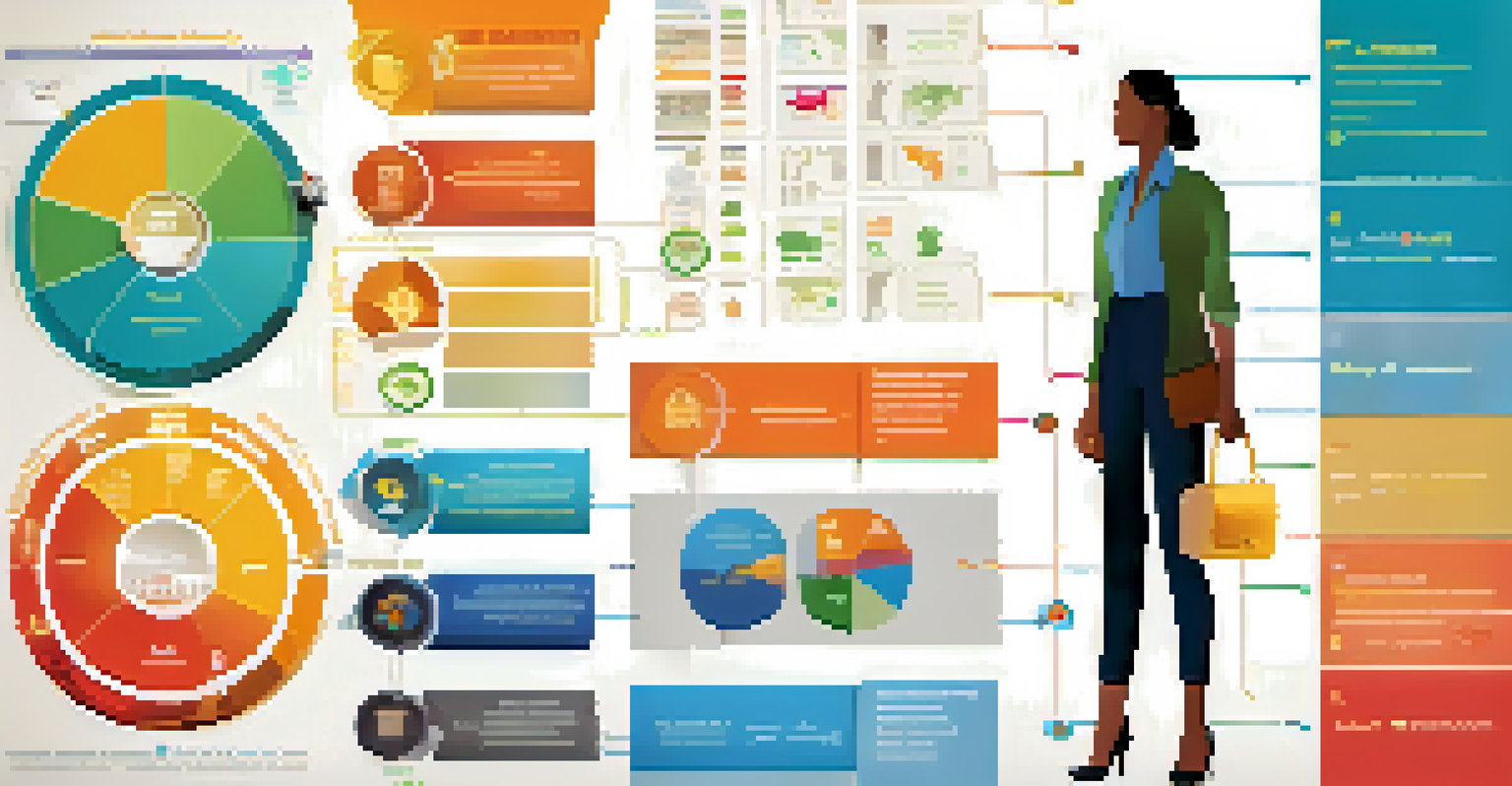Customer Segmentation Techniques for Effective CRM

Understanding Customer Segmentation in CRM
Customer segmentation is the process of dividing a customer base into distinct groups based on shared characteristics. This technique plays a crucial role in customer relationship management (CRM) by allowing businesses to tailor their marketing strategies effectively. By understanding the different segments, companies can identify the specific needs and preferences of each group, leading to more personalized interactions.
The key to successful marketing is understanding your customers, and segmentation is the way to get there.
Imagine a clothing store that offers everything from casual wear to formal attire. By segmenting their customers into categories such as 'young professionals,' 'families,' and 'students,' they can create targeted marketing campaigns that resonate with each group. This not only enhances customer satisfaction but also increases the likelihood of repeat purchases.
Ultimately, effective customer segmentation helps businesses allocate resources more efficiently and improve overall customer experiences. With the right approach, companies can foster stronger relationships and drive growth through tailored communications and offers.
Demographic Segmentation: The Basics
Demographic segmentation involves categorizing customers based on quantifiable attributes like age, gender, income, and education level. This technique is foundational for many businesses as it provides clear, actionable data that can inform marketing strategies. For instance, a luxury brand might target high-income individuals while a budget retailer focuses on cost-conscious shoppers.

Consider a travel agency that segments its customers by age demographics. Younger clients might be interested in adventure trips, while older clients may prefer luxury cruises. By understanding these distinctions, the agency can create tailored packages that appeal to each group’s unique interests and preferences.
Customer Segmentation Essentials
Segmenting customers helps businesses tailor marketing strategies to meet specific needs and enhance engagement.
Demographic data is often easy to collect and analyze, making it a popular choice for businesses just starting with customer segmentation. However, it’s essential to combine this approach with other techniques to gain a more comprehensive view of customer behavior.
Behavioral Segmentation: Insights into Customer Actions
Behavioral segmentation focuses on how customers interact with a brand, including their purchasing habits, brand loyalty, and product usage. By analyzing this behavior, businesses can identify patterns that help shape their marketing efforts. For example, a software company might segment its customers based on whether they are occasional users or daily users of its product.
You can't just throw a bunch of ads at people and hope they stick. You need to know who you're talking to.
Imagine an online retailer that tracks customers who frequently buy sports gear versus those who shop for casual clothing. By understanding these behaviors, the retailer can send targeted promotions to each group, boosting engagement and sales. This tailored approach not only makes customers feel valued but also encourages loyalty.
Incorporating behavioral insights into your CRM strategy enables businesses to predict future behaviors and tailor offerings accordingly. This proactive approach can lead to higher conversion rates and an overall more satisfying customer experience.
Geographic Segmentation: Localizing Your Approach
Geographic segmentation divides customers based on their location, which can significantly influence buying behavior. Factors like climate, culture, and regional trends can affect what products or services are in demand in different areas. For instance, a fast-food chain might promote different menu items in urban versus rural locations.
Consider a skincare brand that tailors its marketing messages based on geographic data. In sunny regions, they might emphasize sunscreen and after-sun care, while in colder areas, they could focus on moisturizers and winter skincare. This localized approach ensures that marketing efforts resonate with the specific needs of each region.
Data Analytics Drives Segmentation
Leveraging data analytics allows companies to continuously refine their customer segmentation for improved targeting.
By leveraging geographic segmentation, businesses can improve their relevance and effectiveness in local markets. This not only enhances customer satisfaction but also drives sales by addressing regional preferences.
Psychographic Segmentation: Understanding Customer Lifestyles
Psychographic segmentation delves into the psychology of customers, including their values, interests, lifestyles, and personality traits. This technique allows businesses to create highly targeted marketing campaigns that connect with customers on a deeper level. For example, a wellness brand might segment its audience into health-conscious individuals versus those motivated by convenience.
Imagine a fitness apparel company that understands its customers' lifestyles. It could market different collections to those who prioritize sustainability versus those who are more fashion-forward. This tailored messaging appeals directly to customers' values and preferences, fostering a stronger emotional connection.
Incorporating psychographic insights can elevate your CRM strategy by ensuring that marketing messages resonate authentically with your audience. This approach helps businesses build loyal customer relationships based on shared values and interests.
Using Data Analytics for Effective Segmentation
Data analytics plays a vital role in customer segmentation by providing insights derived from large sets of customer data. Businesses can use various tools and technologies to analyze purchasing patterns, customer feedback, and engagement metrics. This analytical approach enables companies to identify key trends and make data-driven decisions about their segmentation strategies.
For instance, an e-commerce platform might use analytics to discover that customers who buy baby products are also interested in parenting blogs and resources. By recognizing this connection, the platform can create targeted content that nurtures these customers throughout their buying journey.
Future Trends in Segmentation
Emerging technologies, like AI, are transforming customer segmentation by enabling predictive analytics and personalized marketing.
Ultimately, leveraging data analytics empowers businesses to refine their segmentation continuously. By staying attuned to customer behaviors and preferences, companies can adapt their strategies over time, ensuring continued relevance and effectiveness.
Challenges in Customer Segmentation and How to Overcome Them
While customer segmentation offers numerous advantages, it also comes with its share of challenges. One common issue is the risk of oversimplifying complex customer behaviors into rigid categories. This can lead to missed opportunities for personalization and engagement. To overcome this, businesses should view segmentation as a fluid process that evolves with changing customer dynamics.
Another challenge is data accuracy; if the data collected is outdated or incorrect, it can skew segmentation efforts. Regularly updating customer information and employing data hygiene practices can help mitigate this issue. Additionally, combining multiple segmentation techniques can provide a more comprehensive view of customer needs.

By acknowledging and addressing these challenges, businesses can enhance the effectiveness of their customer segmentation strategies. A flexible, data-informed approach allows for better targeting and more meaningful connections with customers.
Future Trends in Customer Segmentation
The landscape of customer segmentation is continually evolving, driven by advancements in technology and shifting consumer behaviors. One emerging trend is the integration of artificial intelligence (AI) to enhance segmentation processes. AI can analyze vast amounts of data quickly, identifying patterns that may not be immediately apparent to human analysts.
For instance, companies are beginning to utilize machine learning algorithms to predict customer behavior based on historical data. This predictive analytics approach allows businesses to anticipate customer needs and tailor their marketing strategies accordingly. Over time, this can significantly improve customer retention and loyalty.
As businesses adapt to these trends, they will need to remain agile and responsive to changes in customer preferences. The future of customer segmentation holds exciting possibilities, promising more personalized, relevant, and engaging customer experiences.